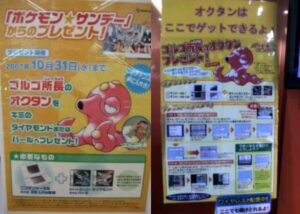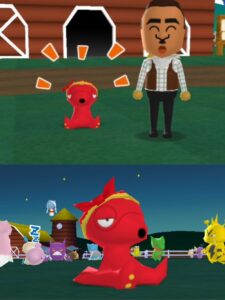This is part 3/3 in a series on the official event Pokémon inspired by the star-studded cast of Japanese variety TV show “Pokémon Sunday” and the occasional improbable heroics of spotlight Pokémon. Part 1, detailing Shokotan Tropius and essential programme background, can be found here. Part 2, on unlikely MVP Yamamoto Whiscash, is found here.
—
Sunday Special #3: Golgo Octillery, October 14 – 31, 2007
Golgo. Funny name isn’t it? It won’t surprise you to learn that it’s a stage name. The professional comedian’s real name is Masahiko Matsumoto, and he chose the professional handle “Golgo” (or Gorgo) in reference to a long-running manga you’ve likely never heard of (“Gorugo 13” or『ゴルゴ13』), for which he penned fan fiction when he was just beginning to make his way in the world. With his trademark outlandish white-and-gold Pokéball suit that somehow complemented his bald head and finely-trimmed moustache, Matsumoto’s co-hosting persona of “Chief Golgo” was a permanent fixture of Pokémon Sunday and successor show Pokémon Smash right up until 2013. The man was practically part of the furniture.1 That well-groomed two-finger ‘stache to go with his cueball look makes me a little uncomfortable, though. I try to think of the toothbrush trim as a Chaplin homage, but portraits of Hideki Tojo keep coming to mind. Anyway.
As was, for a time, his Octillery. After debuting on Pokémon Sunday episode #124 (aired February 25 2007) where it upset a Swampert but fell to a Giratina, Chief Golgo regularly made battle on the show with his pet octopus. Now, Octillery isn’t what you’d normally consider a top-tier competitive Pokémon. Let down by low speed and notable frailty, Smogon diplomatically describes the eight-legged turretfish as a “mixed bag” that “needs a bit of help to achieve its full offensive potential”. Yet under Golgo’s guiding hand, Octy put in a string of impressively improbable clutch performances that saw it far exceed its theoretical potential. The key factor in this regard was a certain held item, a Focus Band (きあいのハチマキ), which, when activated (at a 10% chance), enables the holder to live down an otherwise fatal attack at 1HP. Golgo’s deceptively competent Octillery did this repeatedly, becoming a bit of a cult hero in the process. So. Let’s dive in!
Golgo’s Octillery first turned heads in March 2007 during the show’s “Spring Break Battle Special” that saw Chief Golgo and Shokotan team up in a televised doubles match.2 Episode #128, aired March 25 2007. Their opponents were two schoolboy challengers, for whom a win stood to translate to a boatload of Pokémon merchandise in prizes. “Banzai” headbands tied firmly around their foreheads, the kids certainly meant business and signalled a clear intent to claim victory. And sure enough, the children overpowered the Shoko-Golgo tandem, who had no answer to the schoolboys’ assembly of legendaries and thus suffered a resounding defeat.
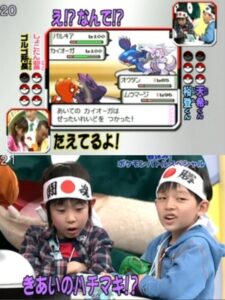
Sheer Cold connects, but Octillery lives (top); “Focus Band!?”, the subtitles read. Priceless (bottom). Stills from: Pokémon Sunday #128, via pocketmonsters.net
But, in this fairly hopeless loss, one Sunday Pokémon had shown a remarkable fighting spirit, a dogged determination to thwart the foe as long as possible and squeeze every ounce of combat capability from its modest talents: Golgo’s Octillery. Midway through the battle, it was hit by a normally-unsurvivable on-target Sheer Cold from the foe’s Kyogre (the move guarantees an OKHO). Yet Octillery lived to tell the tale – for another turn, anyway. That nobody remotely expected this to happen is evident from the reactions of both Team Sunday and their youthful opponents, the former cheering with delight, the latter astonished as they tried to work out what on earth just happened. It took a moment before the penny dropped: Octillery must’ve been holding a Focus Band! (A full selection of episode images is found here.)
This high-stakes battle got the TV audience’s blood pumping, and was sufficiently exciting to get at least one blogger (Mabinogi) to express their thoughts about it. “It seems Shokotan couldn’t believe she lost!”, they wrote.3 In Japanese: “前のポケサンの「春休みバトルスペシャル!」で。しょこたんが負けたとは信じられなかったような信じれたような。しかし対戦相手の天希くんと祐登くんTUEEEEEEE” (I doubt it.) More to the point, the remarkable performance of Golgo’s Octillery invited much discussion on Japanese messageboard Mixi.jp throughout April-May 2007 – such that players were inspired to try and experiment with a Golgotillery replica in a competitive environment, even if the Chief had a strange liking for running the ineffectual Bullet Seed over Signal Beam. (Note: if one thing is fantastic about Octillery, it’s the Pokémon’s immensely diverse movepool.) One user commented how they had “burst into laughter” when Octillery weathered Kyogre’s Sheer Cold.4 Post #21, May 20, 2007, at: https://mixi.jp/view_bbs.pl?comm_id=2023567&id=16982079 It’s worth emphasising just how unusual this scenario was: Sheer Cold is not a particularly great move to run on Kyogre, who has far better options at his disposal. Yet the opponent ran it. Moreover, Sheer Cold has a fixed 33% (1/3) hit rate, while Focus Band activates only 10% of the time, putting the odds of this happening consecutively at a mere 3%. You couldn’t stage it for live TV if you wanted to! Little did everyone know, of course, that this sample of chance-y combat hardiness was but a taste of things to come.
Fast-forward a few episodes to Pokémon Sunday #148, aired some months later, on August 12 2007. Once again, Shokotan & Chief Golgo stood ready to take on special guests, a duo of elementary school girls this time around. As previously, Golgo’s Octillery featured in the lineup. Their Diamond & Pearl double battle started out unremarkably and for a time proceeded evenly, with the girls losing their Milotic, Empoleon and Lucario contra Shokotan’s Darkrai and Golgo’s Carnivine, then Garchomp, all three of which also fell. Team Sunday’s fate seemed sealed, however, when the guests next fielded the powerful pairing of Dialga and Latios to Shokotan’s Charizard and Golgo’s unassuming Octillery. Yet as the legendaries began to focus down the helpless-looking octopus, something wonderful happened.
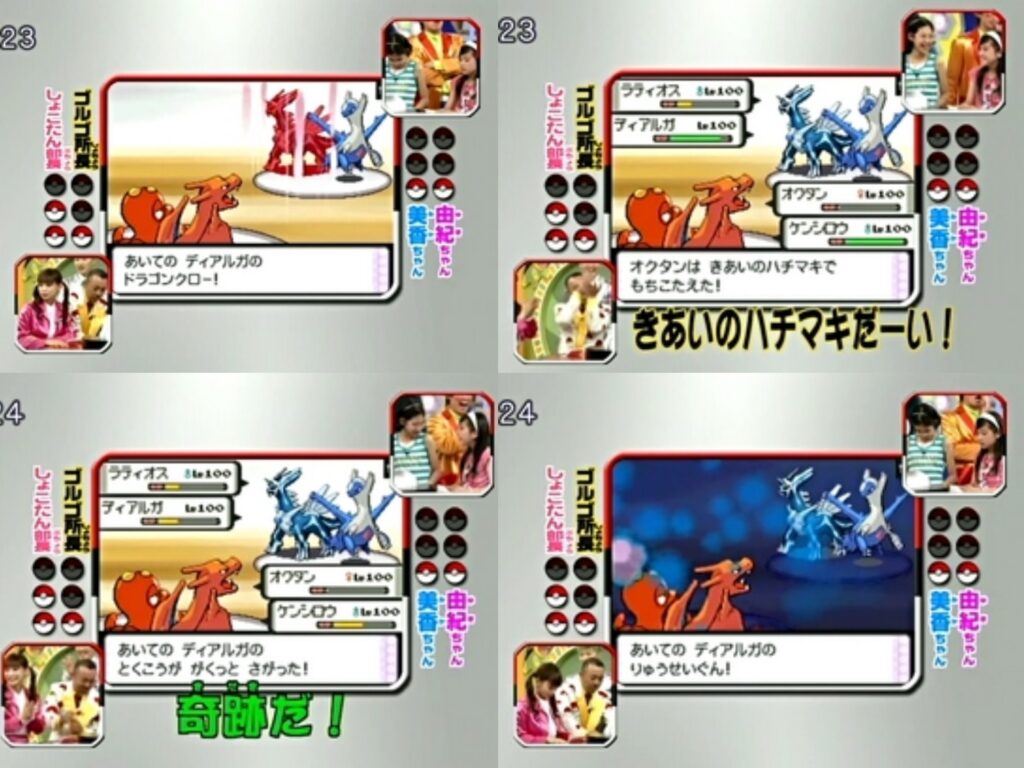
Clockwise, from top-left: (1) Dialga uses Dragon Claw; (2) Saved by the Focus Band; (3) Dialga uses Draco Meteor; (4) It’s a Miracle! Stills from: Pokémon Sunday #128, via pocketmonsters.net
Poised to make quick work of the octopus, Dialga fired off a Dragon Claw. Octillery’s health bar duly emptied out, only for the ticker to stop at one remaining hitpoint. Saved by the Focus Band! Judging from stunned looks not unlike those of the schoolboys some months prior, the girls had not accounted for this possibility. Octillery’s unexpected resilience enabled it and its partner, a somewhat roughed-up Charizard, to retaliate, taking chunks out of both Latios’ and Dialga’s lifebars. The battle was not decided yet! Seeking to deliver the coup de grace, Dialga struck Octillery again on the next turn, this time with Draco Meteor. Miraculously, Octillery’s Focus Band again activated, enabling it to tank the hit while already at a single lifepoint.
Sunday staff couldn’t believe their eyes and were jubilant in their celebrations. “It’s a miracle!”, they shouted. Capitalising on the opportunity, Charizard took down the offending Dialga with Heat Wave before falling, leaving last-moving Octillery to stare down Latios, then eliminate it with a mighty Hyper Beam. Team Sunday victory! To recap: Focus Band has but a 10% chance to activate on a fatal blow, putting the odds of successive activation at a mere 1% (1/10 * 1/10). This sequence of events is what came to be known as the “Octane Miracle” (オクタンの奇跡), and it cemented Golgo Octillery’s reputation forevermore.
I’m pleased to say I’m actually able to share a clip of this now-classic Sunday battle with you, courtesy of Twitter user @WsT3b, who posted a montage online in March 2019. (I would point you to a Tokyo.TV Pokémon Sunday video archive, but I don’t believe there is such a thing.)
皆さんの所長のオクタンとポケモンサンデーの愛のおかげで、バズりました爆笑
皆さんに言われてもう一つ奇跡の名シーンがあったのを思い出したのでこっちも載せときます✨ pic.twitter.com/sNd8O6PaVK
— ??ウッチー? (@WsT3b) March 11, 2019
Plenty of remnants remain of the animated online discussion that followed the airing of the episode. For instance, a mixi.jp BBS user saw to comment “Last week’s Pokesan’s Golgo was amazing. That Octane, I thought it was divine intervention!”5 August 19, 2007, in Japanese: “先週のポケサンのゴルゴはすごっかた… まさしくオクターン、神が降臨したかと思いました” Fans began to ascribe mythical qualities to Golgo’s octopus. Contended one follower: “You can try and emulate it, but if Chief Golgo isn’t the one using the Pokémon, the Octillery will not exert its true strength.” Lifestyle blogger yatume commented how Octillery was “amazing”, adding they’d never before seen Focus Band activate twice in an online match. One “nintendoutei64” echoed these thoughts, additionally musing that it must be a “pleasant sensation” to have Focus Band reactivate at 1HP. Everywhere the term “Octillery Miracle” resounded.
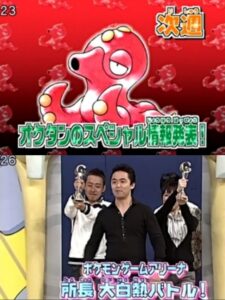
“Special Information Announcement” (top); Masuda’s glamorous entrance is teased (bottom). Yeah, I’m not sure what’s up with the trophies either. Stills from: Pokémon Sunday #156, via pocketmonsters.net
Folks calling the shots at Sunday were certainly not oblivious to the Pokécommunity’s wholehearted embrace of Golgo’s Miracle Octy, and look to have realised they were sitting on promotional gold mine for both show and franchise. Pokémon Sunday episode #156 (of October 7, 2007) broadcast a montage of clips dubbed “Chief’s Octillery Famous Battle Collection” (所長のオクタン名バトル集) that recapped Octillery’s extraordinarily achievements in battle to date, feeding the octopus’ burgeoning personality cult. The episode further teased a “Special Information Announcement” (スペシャル情報発表), and announced an upcoming televised Sunday battle versus GameFreak Director Junichi Masuda. Sunday’s Shokotan and Robert had visited the GameFreak offices multiple times throughout 2006-07; now, Masuda would travel in the other direction and join Sunday’s cast on the livestage floorboards as a special guest.
One week later, the highly anticipated episode #157 aired (October 14 2007). As Sunday’s traditional anime segment concluded, 6 Pokémon anime episode repeats were a mainstay of Sunday throughout its multi-year run; the programme usually led with them. Masuda was already present on the set flanked by the show’s full cast, DS Lite in hand ready to make battle. Without much in the way of introductory small talk, the show transitioned right into a Chief Golgo-Masuda showdown. (Junichi Masuda evidently was a household name to Pokéfans by this point.) Unlikely the previous battles, the arena was to be not be a Diamond & Pearl singles match, but a showdown in Colosseum-style brawler Pokémon Battle Revolution. Was Octillery to pull the chestnuts out of the fire for Golgo once more?
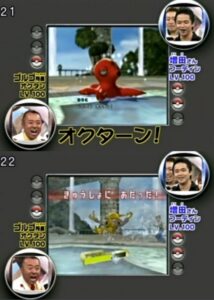
Encouraged by a furious shout, Octane joins the fray (top); Masuda’s Alakazam falls to a critical (bottom). Stills from: Pokémon Sunday #157, via pocketmonsters.net
Golgo led with Raichu to Masuda’s Pikachu. (Which couldn’t have been a PKTOPIA Surfing Pikachu by any chance, Junichi?) Leaning on superior stats, Raichu swiftly took out the thunder mouse, but in turn was knocked out by Masuda’s Alakazam, as was the Chief’s Infernape. As so often, this left only Octillery to save the day. With a trademark “Octaaaan!” cry, Golgo sent the hardy octopus onto the field. A sensation seemed at hand when Golgotillery swiftly subdued Alakazam with a critical hit However, Masuda’s closer – Milotic – proved to be a terrible matchup for Octy, and when Focus Band failed to activate as Milotic struck with Surf, the battle ended abruptly.7 I’m not fully certain that it was Surf. It may have been Hydro Pump. The “God of Pokémon”8 ポケモンの神; words of blogger “gamp” at https://gamp.ameblo.jp/frio84/entry-10052157864.html was not be defeated.
In the after-action discussions that followed, Masuda offered the Chief expert advice: change up some of Octillery’s learned moves, and it’ll be more effective in battle. Pretending to contemplate the situation for a moment, Masuda continued: let’s replace Surf with Signal Beam, and we can make Octillery a present. A distribution present to the fans like Tropius and Whiscash before it, queried Shokotan. Yes, exactly so! With that, the event Pokémon “Golgo Octillery” was announced. And, the programme assured viewers, Octillery would be holding its signature Focus Band!
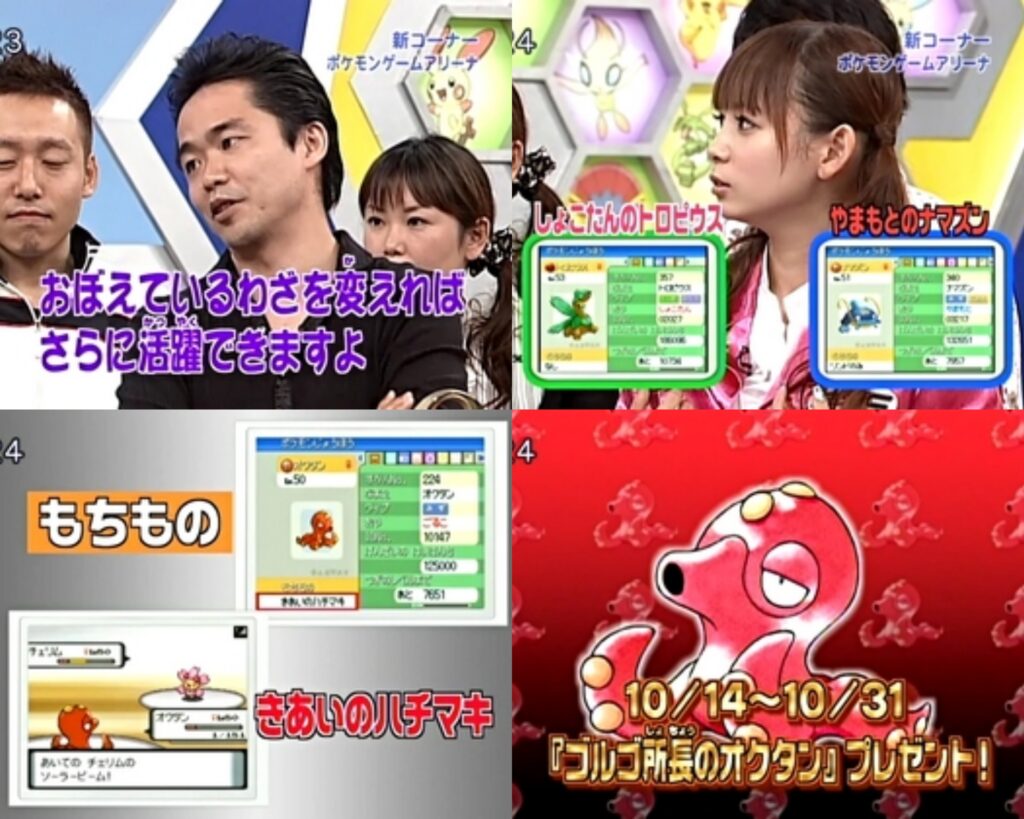
Clockwise, from top-left: (1) Masuda proposes optimisations; (2) A present, like Tropius and Whiscash?; (3) Octillery’s distribution is announced!; (4) Focus Band included! Stills from: Pokémon Sunday #157, via pocketmonsters.net
That very same day, a newspost went up on the official Pokemon.co.jp website. Starting October 14, the “Octillery that had been enjoying miraculous success” (it literally used the phrase “奇跡の大活躍”) was to be available from all PokéCenters and Pokémon Towns, as well the usual selection of participating stores. Like Whiscash, Octillery was to be distributed exclusively over local wireless connection, with the official website instructing players to collect Octy from near its promotional posters (see images). In a clear sign that pulling local event Pokémon from the aether had become second nature to the franchise fanbase, contemporary weblogs were practically silent on the logistics of this distro. No more were the first-hand accounts of router-range queues, confused parents, and puzzled kids. Only blogger “freescenario” voiced some residual overcrowding concern as relating to PC Tokyo’s relocation to Hamamatsucho and the loss of its rooftop event space:9For the amazing department store sky-garden space used to distribute Yamamoto Whiscash in Tokyo, see here. “I was worried about what would happen with the first distribution in Hamamatsucho, but it was distributed [without problems] under the [outdoor] overhang to the right-hand side of the store.”10In Japanese: “初めての浜松町での配布ということでどうなるかと不安でしたが、店の右側の屋根のあるスペースで配布されていました。” Apparently the signal was strong enough that Octillery could be received from the nearby Seven-Eleven.
Now, we might entertain the theoretical possibility that few bloggers covered Golgo Octillery’s distribution conditions simply because few cared to go and collect one. But frankly, that seems unlikely. After all, Golgotillery’s improbable repeat heroics had made it a crowd favourite and boosted its popularity to the lofty heights occupied by Shokotan Tropius. (And Tropius, mind you, reflected Shokotan’s own glittering stardom rather than a self-made fame earned in battle.) But don’t just take my word for it. Consider blogger “mie-kun” for instance, who by their own admission wasn’t at all planning to visit the PokéCenter on October 14th, but after watching that morning’s Sunday broadcast (where Golgo Octillery took on Masuda-san), couldn’t help but go!11 Their weblog at: http://mie-kun.moe-nifty.com/game/2007/10/post_cd21.html Or Montan, who observed at PC Tokyo on a weeknight: “The age of people who come to collect Octillery varies: parents and office workers, college students, even some who seemed to be high school girls – I got Octane mixed with these people.” And a little closer to the present-day: Twitterer @WsT3b’s combined Octillery heroics clips (see also below) have been viewed over half a million times since their posting in March 2019 and invited thousands of fondly reminiscing responses on the platform. If the fact that Japanese Pokéfans’ excellent collective memory of televised events last seen a decade prior isn’t conclusive evidence of just how strongly Golgo Octillery’s miraculous accomplishments spoke to the imagination of Japanese children back in 2007, I don’t know what is.
A common theme by this point was how even casual event collectors began to bump up against wondercard storage limits. To recap, wondercards were (and are) little business card-like memorabilia that are automatically inserted into a Pokémon game’s digital card album whenever a person picks up an event Pokémon, either as a global download, via local wireless, or through slot-2 distribution. Diamond & Pearl allowed only a maximum of three wondercards to be kept on any given savefile at a time. Perhaps for this reason, the Octillery wondercard flavour text explicitly instructed players to throw it away after redeeming the Pokémon (see below).12A thank you to JYR and Tselino for confirming this translation. Players were forced into hard choices: in order to pick up Golgotillery, what do I delete? The shareable MagBuzz wondercard, the first-ever Manaphy’s distribution (Water Tribe) commemorative card, Shokotan’s personal “rairai-o” thank-you note, or maybe the Movie Darkrai card? Or perhaps any of three PalCity wondercards? Torogamer had summarised this conundrum in the context of Whiscash some months prior:
“A message from [Pokémon Sunday’s] Yamamoto was written on the back of the wondercard. There are ways to use the card after getting the handout, and some have fun messages written on them, so I’d like to keep them all if possible… Unfortunately, three cards is the maximum. This time, for the first time, I resolved to delete cards on some software copies. As much as possible, I tried to retain at least one card copy across my softwares, but if the number of cards increases in the future, it will become difficult.”
For those regarding past distributions with a keen sense of history, this was a truly impossible choice to be made over and over again, and you’ll be unsurprised to learn that the next generation of games (Unova) did away with this arbitrary data storage limit. Golgotillery’s wondercard message, incidentally, was not terribly creative, asking players to take good care of Miracle Octane but failing to even reference the Focus Band!
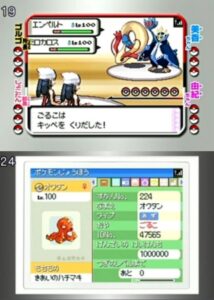
Note the Chief’s female player character (top); his TID exposed (bottom). Stills from: Pokémon Sunday #148 & #173, via pocketmonsters.net
Curiously, we have fairly extensive knowledge of Chief Golgo’s personal Sinnoh save file and the original Golgotillery he caught on it. While it’s unknown (to me, at least) whether he owned Pokémon Diamond or Pearl version, his original Trainer ID (or TID) is well-documented as 47565. Contemporary wiki website “netapoke” lists as much, and Pokémon Sunday screenshots confirm it. Furthermore, Pokémon Sunday’s tag-battle loading screens reveal that Golgo’s trainer character was female. Why this was so, I’m not sure: Chief Golgo himself was decidedly male, as indicated by his balding head and fashionably groomed facial hair. His opposite-sex avatar was named goruko (ごるこ), which – if I had to take a stab – is likely an intuitively feminine-sounding derivative of his stage name gorugo (ゴルゴ). Then Octillery itself: it was female, its nature Serious, and was apparently caught (as a Remoraid) on November 26th, 2006. Again, netapoke doesn’t list its source, but I consider it probable that the Chief briefly flashed his Octy’s summary screen on TV one Sunday episode.13 As found on netapoke: “おや:ごるこ(沙織曰く、お金持ちのお嬢様)
ID:47565 (オリジナル)
ゲット日時:2006ねん11がつ26にち”
The public distribution Golgotillery accurately inherited these identifiers, including the female OT gender (as indicated by a Trainer Name rendered in pink), Octy’s female Pokémon gender, and its Serious nature. Only the TID was modified from 47565 to 10147 to reflect an initial distribution date of October 14, 2007 (10-14-7). Its moveset, too, was faithful, comprised of Golgo’s favoured Octazooka / Ice Beam / Hyper Beam plus Signal Beam as proposed by Masuda.14 Golgo had frequently rotated the fourth slot move, variously running Bullet Seed, Bubblebeam, and ultimately Surf in the battle versus Masuda, to later replace it with Signal Beam. Source is netapoke. And like Sunday Specials Tropius and Whiscash, Octane came in a Cherish Ball, and had no ribbon attached (meaning it could, in fact, be traded on the GTS.) Finally, it quite naturally held a Focus Band in the equip slot. I’m positive that had it been possible to retroactively implement a custom portrait and/or sprite for Golgotillery into Diamond & Pearl retail copies – Focus Band fastened tightly around its head – the programmers would have done so! But, alas. ‘Twas the age before downloadable update patches.
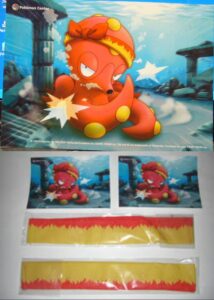
Octillery sticker close-up (top); sealed “Focus Band” headbands (bottom). Image credit: yassy0825 & gamediary21
It was also still the era of physical present-giving. Not be deterred, GameFreak found another way to make the Focus Band a spotlight item and serve fans itching for more hachimaki goodness. Or, perhaps, it would be more accurate to say that The Pokémon Company found PokéCenter marketing value in Octillery’s fame. In late November 2007, a newspost appeared on pokemon.co.jp that announced a free special issue Golgo Octillery sticker for anyone that bringing an Octane of level 65 or above to PC Tokyo, Osaka, Nagoya, Fukuoka or Yokohama during the period from November 23 to December 9. Which, of course, required raising Octillery fifteen levels as a testament of true love for the Pokémon. I know that a sticker for a gift sounds corny and underwhelming on paper, but it looks to truly have been a high-quality memento. Rather than tiny thumb-sized trifles, the stickers were the size of a postcard, and depicted a confident Octillery assuming an artistic combat pose inside of a sunken city, Focus Band wrapped tightly around its bulbous head. Furthermore, the first 10,000 people to show said 65+ Octy at PC Tokyo only were eligible to receive a real-life Focus Band. Which is to say: an actually wearable headband, manufactured – if I’m seeing this right – out of stretchy fabric. Cool. Really cool.
Now, you’re forgiven for thinking that the story of Octillery inevitably ended here. Heroics achieved, accomplishments celebrated, metaphorical victory arch built – what could possibly remain but hard-earned, well-deserved early retirement in caring hands, much like Yamamoto Whiscash? Well! There is, in fact, one more dramatic chapter to the legend of Octane. And I’ll try and be concise about it, because this article’s word count is getting out of hand. Never did I imagine there was this much substance to Golgo’s octopus.
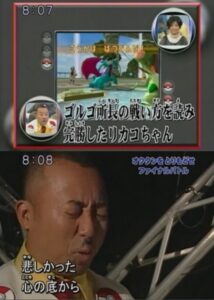
Rika sweeps the floor with the Chief’s Pokémon (top); this is what heartbreak looks like (bottom). Stills from: Pokémon Sunday #193, via pocketmonsters.net
For a time, it indeed seemed as though Golgo’s Octillery was primed to live out his days in comfort under a surrogate mother. On episode #173 (aired February, 2008) elementary school challenger Rika (利佳) defeated the Chief in a classic D&P singles battle. Whether conceded as spoils of war or given up and entrusted voluntarily, Golgo’s famous Octillery changed hands afterwards. But, unable to relinquish his dear Octane, Golgo invited Rika back for a Sunday rematch that was branded, somewhat belligerently, a “revenge match” (リベンジマッチ). This chance to prove his worth and win back Octy aired April 13, 2008 (#182), but once again Golgo suffered defeat, Rika’s Flygon proving too mighty as it had been two months prior. Finally, heartbroken, Chief travelled to his subduer’s family home and begged for a final rematch. This “Last struggle for my Beloved Octane” took the form a specially-staged battle at Yokohama Arena. And yet, in spite of the high emotional stakes, Golgo lost for a third consecutive time to the girl challenger. However, just as Golgo bemoaned that Octane had been taken from him forever, Rika revealed a twist: in the intervening months, she had bred Octillery offspring in the game. Now the proud parent of “Okotan”, a direct descendant of the famous octopus, the OG Octilery could be graciously returned to Chief Gorgo – a trade that was promptly made. As a token of gratitude for her extraordinary foresight and generosity (not to mention victories), Rika received Regigigas and Shaymin plushies.
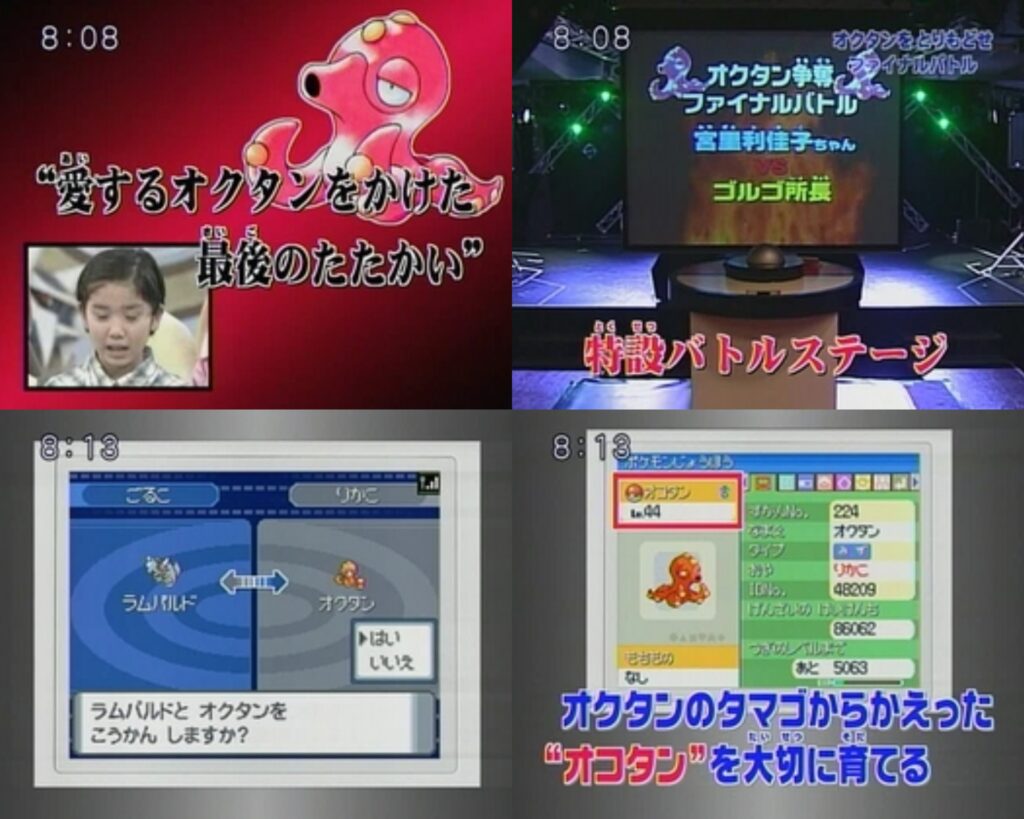
Clockwise, from top-left: (1) “The last struggle for my beloved Octane”; (2) The stage: Yokohama Arena (3) Direct descendant “Okotan”; (4) Octillery and Golgo reunited! Stills from: Pokémon Sunday #193, via pocketmonsters.net
Now, having gone through this ordeal, did that mean rest and retirement for Octillery? I’m afraid not. ‘Twas a combat octopus, after all! Octane remained a staple of the Chief’s lineup, displaying its arsenal of skills and tricks a few times more throughout the years. Take, for example, the episode of Pokémon Smash where Octy scored an unlikely knockout on the then-recent shiny event Pokémon “Movie 10” Suicune as fielded by fellow cast member Hiroyuki Baba. As so often before, Focus Band was activation was critical. This, too, I am able to show you courtesy of @WsT3b – his two-minute Smash clip has been viewed nearly half a million times since its posting.
同世代じゃないとわからないんだけど…
ポケモンサンデーっていう10年前ぐらいにやってた番組で、9年前公開の「幻影の覇者ゾロアーク」っていうポケモンの映画でもらえる色違いスイクンの強さを見せないとダメなのに…
ゴルゴ所長のオクタンが奇跡起こして、逆転しちゃうシーンが忘れられない? pic.twitter.com/Z0Uw9LPYZP
— ??ウッチー? (@WsT3b) March 9, 2019
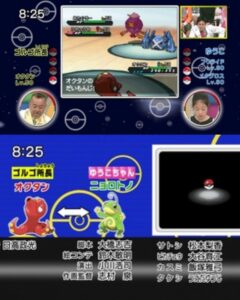
No chance for Octillery (top); is this goodbye? (bottom). Pokémon Smash #138, via pocketmonsters.net
Octane even made the transition to next-gen Pokémon Black & White, appearing occasionally in battle on successor show Pokémon Smash alongside other Golgo classics Sableye and Magnezone. In June 2013 (Smash #138), Octillery found itself in the thick of it once more, hopelessly outmatched as the sole survivor in a matchup versus Metagross and Drifblim. It fought valiantly, but fell nonetheless, no Focus Band Miracle to turn the tide this time. (Frankly, it couldn’t have taken out Metagross even with a triple headband activation.) In a shock on-air exchange after the engagement, the girl invitee traded her Politoed for Golgo’s Octillery. Fans like to believe that canonically, she received a replica from Golgo, the original thus staying with him. And while this may seem like a piece of wishful thinking, later events do lend credence to this theory. Notably, Golgo’s own Octillery made one final TV appearance – for now – on distant Sunday successor show Pokenchi (ポケモンの家あつまる?) in 2016. Now a special guest on a Pokéshow himself, the Chief took on co-host Abareru-kun with a full team of Golgo signature Pokémon: Sableye, Magnezone, and Octillery.15 These scenes are on YouTube. For now. Link: https://www.youtube.com/watch?v=P0jI5jQCjkk And, as fate would have it, in a one-on-one, last-man standing showdown against Machamp, Octillery’s Focus Band activated, enabling it to endure an otherwise fatal blow and therefore securing a knock-out with Psychic. And the win.
Then there is one last Golgotillery dimension to be considered. (This truly is the last section. I promise.) Not long after its 2008 return from a sojourn at Rika’s, Golgo’s Octillery was immortalised a second time: in Pokémon Ranch. This obscure piece of WiiWare is today mostly forgotten, but back in Generation Sinnoh, it served as an altogether not too-convenient Pokémon mass storage solution for Pokémon Diamond, Pearl, and Platinum. And, for a short while, it saw Pokémon event distributions of its own. Crowd favourite Baba Flygon came to Ranch, as did Akiyama Slaking and Red Metagross. All of which, you will note, are replicas of Pokémon owned by Sunday’s cast. Inevitably, given Octillery’s popularity, it too was transformed into a Ranch event. After downloading a short-lived live update in May 2008, players found that a Chief Golgo “Mii” appeared on their farm, who would offer to trade you his legendary octopus in exchange for a Zigzagoon. More impressive than the resulting Pokémon itself – which was a carbon copy of 2007’s Golgotillery event wrapped in a fresh TID – was the fact that a custom Ranch 3D model had been created for it. As distinct from any standard Octillery imported into Ranch, this repeat Golgotillery wore an unremovable Focus Band around its head. What couldn’t be done in Diamond & Pearl a year earlier was possible now, in the patchable Ranch – and fans loved it.
Incidentally, as far as I know, this marked the one and only time that a Pokémon’s video game appearance was expressly modified to conform with officious Pokélore conceived wholly by chance on a third-party TV show. Which tells you just how deeply Golgo Octillery’s mythical, almost mystical abilities had become embedded, ingrained even, inside the fabric of Generation Sinnoh. And, in turn, that this could happen at all speaks volumes about the power of Sunday’s grip on the Poké-psyche of the time. On that note: I started this trilogy by pointing out that Shokotan made Sunday, and Sunday made Shokotan. I still very much think that’s accurate. Having completed this all too fleeting exploration of Sunday, I would proffer that during its heyday, Pokémon made Sunday, and Sunday made Pokémon – with Golgo’s Octillery, for a time, the centerpiece of it all.

